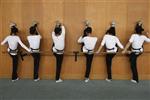 |
 |
 |
||
    |
||||
|
||||

Exercise therapy best way to treat groin pain
|
|
Reuters Health
Wednesday, April 15, 2009

But it remains unclear how frequently these exercises should be performed or at what intensity, Dr. Zuzana Machotka of the University of South Australia in Adelaide and her colleagues conclude.
Groin pain is common in athletes, Machotka and her team note in their report, and can stem from several different points in the body, including the lower back, hip joint and lower abdomen, making diagnosis complex. Athletes in sports that involve running, physical contact and repeated kicking are at the greatest risk of groin pain, they add.
While treatment of groin pain typically includes exercise therapy, there is little evidence on which approach is best, the researchers state. To begin to provide an evidence base, Machotka and her team searched the medical literature on exercise therapy for groin pain. They included five studies in their analysis.
Each study looked at a different exercise protocol, but all demonstrated that exercise had to become progressively more difficult for the intervention to be effective, the researchers found.
The researchers also found that interventions worked best when they were offered one-on-one or to small groups, along with jogging, running, cycling or another "established co-intervention." But there was little evidence that medication or passive treatment were effective.
The best exercise appeared to be strengthening of the hip and abdominal musculature.
Interventions lasted for about 4 to 16 weeks, which "is in stark contrast to routine practice, where there is often great pressure on all concerned to return an athlete to their sport," the researchers note.
They conclude: "This review helps to affirm commonly held clinical opinions that exercise therapy can play a crucial role in attaining positive outcomes for athletes with groin injury."
Reuters Health
© 2009 Thomson Reuters. All rights reserved. Reuters content is the intellectual property of Thomson Reuters or its third party content providers. Any copying, republication or redistribution of Reuters content, including by framing or similar means, is expressly prohibited without the prior written consent of Thomson Reuters. Thomson Reuters shall not be liable for any errors or delays in content, or for any actions taken in reliance thereon. "Reuters" and the Reuters Logo are trademarks of Thomson Reuters and its affiliated companies. For additional information on other Reuters media services please visit http://about.reuters.com/media/.
Related News:
More News on this Date
Related MedlinePlus Pages:
| Home | Health Topics | Drugs & Supplements | Encyclopedia | Dictionary | News | Directories | Other Resources | |
| Disclaimers | Copyright | Privacy | Accessibility | Quality Guidelines U.S. National Library of Medicine, 8600 Rockville Pike, Bethesda, MD 20894 National Institutes of Health | Department of Health & Human Services |
Date last updated: 16 April 2009 |
